
Animal Aid : NEW CAMPAIGN LAUNCH: Sign our petition to end greyhound racing In England !
How to get involved
Whether you’re a seasoned campaignhttps://www.animalaid.org.uk/the-issues/our-campaigns/greyhound-racing/er or are taking your first steps into animal activism, there’s a way you can help!
You can:
Sign the petition and share with everyone you know!
Join in with a peaceful demonstration at a greyhound track or help run a stall in your town centre. Find out more by getting in touch with us here
Order campaign resources such as leaflets, posters and stickers
Share our social media posts
Talk to your family and friends about why it’s time to end greyhound racing!
Our campaign launches with a two-week advertising campaign, Hounds of the Underground. Bright and colourful graphics will be splashed across London Bridge, Victoria, Waterloo, King’s Cross St Pancreas and Tottenham Court Road tube stations, telling the stories of survivors from the racing industry. These ads will be up until the 24th August, so if you see one on your travels, make sure to tag us and use the hashtags #HoundsOfTheUnderground #EndGreyhoundRacing
The ads will be asking people to sign our government petition to end greyhound racing. You can also get in touch with your MP and ask them to sign this EDM!
source https://www.animalaid.org.uk/news/new-campaign-launch-sign-our-petition-to-end-greyhound-racing/
-
The UK Greyhound racing industry are allowing monthly LIVE Auctions of these poor greyhounds.
The https://greyhoundtrader.com/track-sales/
Its not clear what is happening to the greyhounds that are not being sold when they dont get the asking price.
Update: UK Live and Online Sales of Greyhounds where are these Greyhounds being sold ?

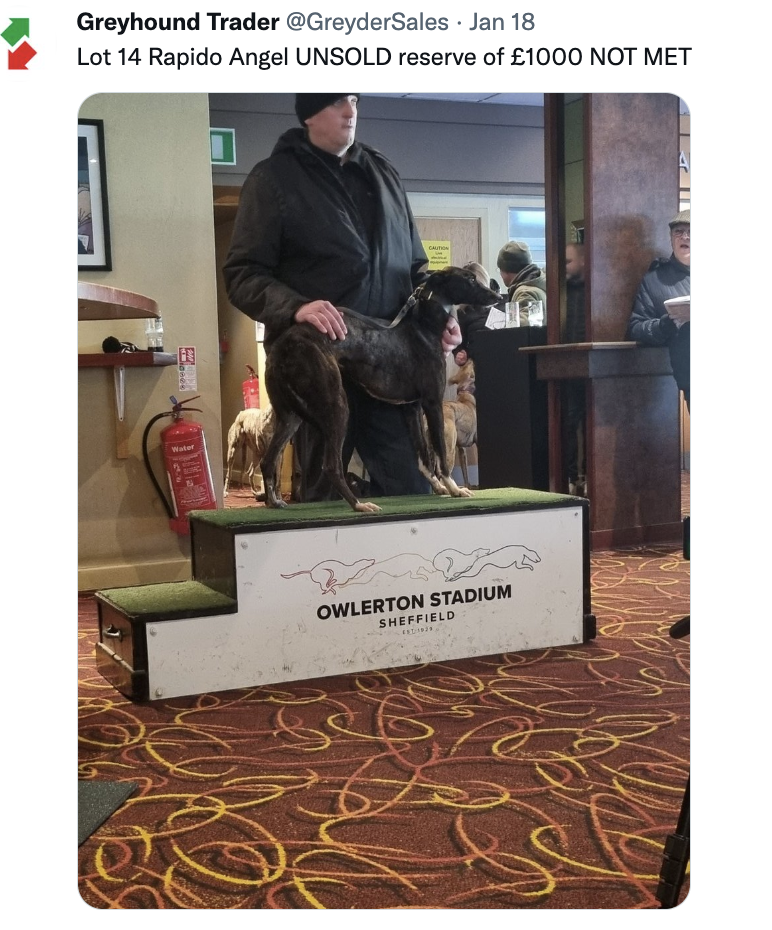
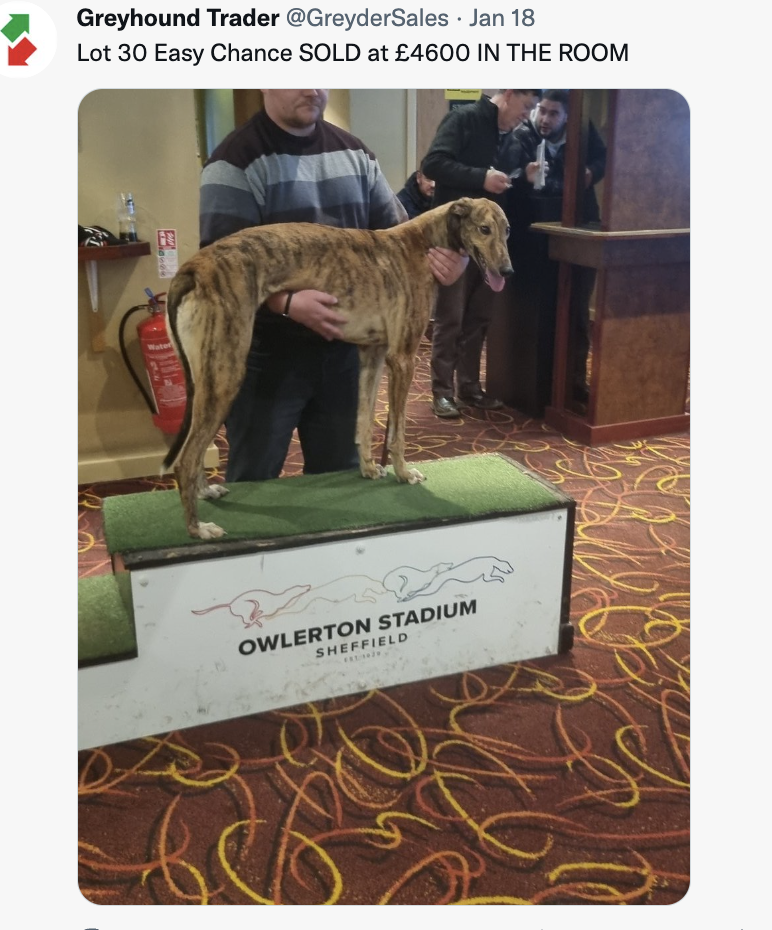
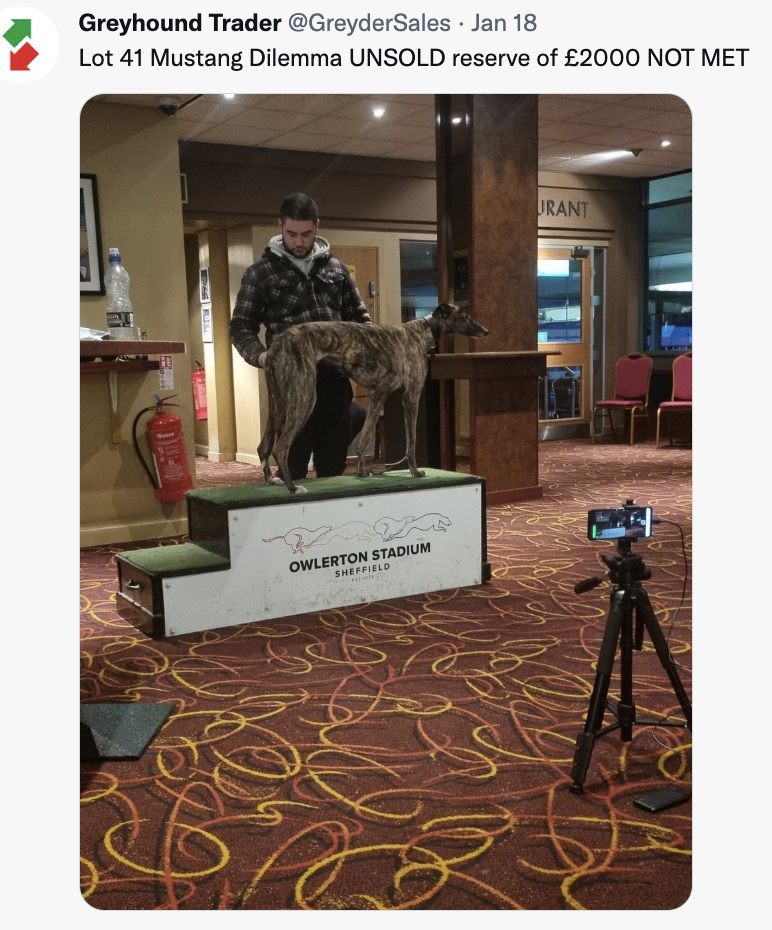



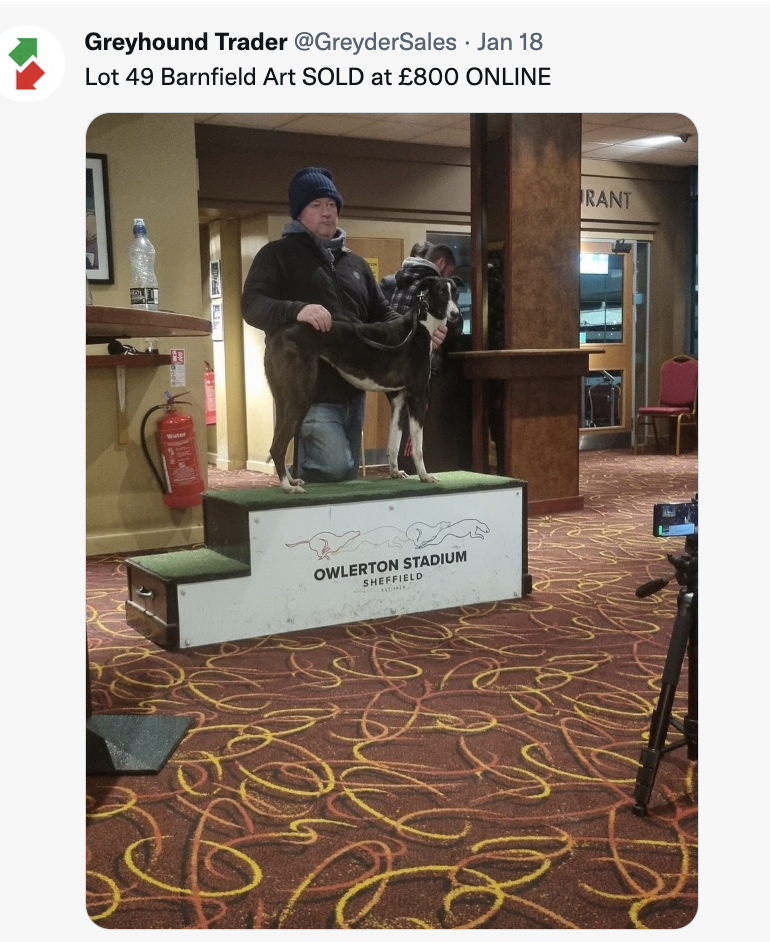
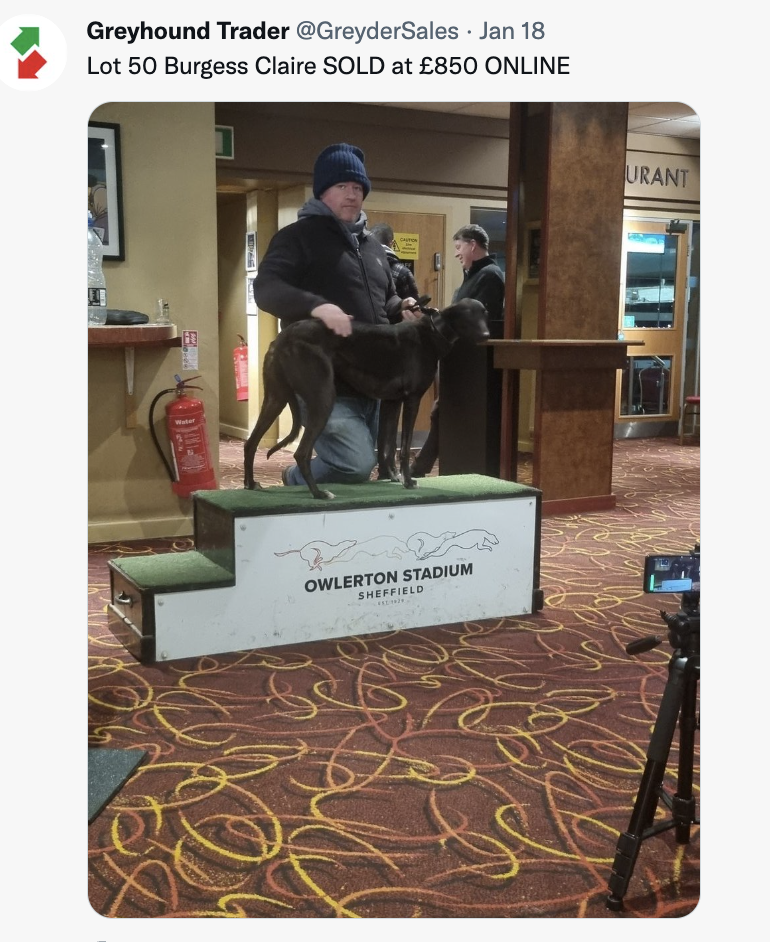
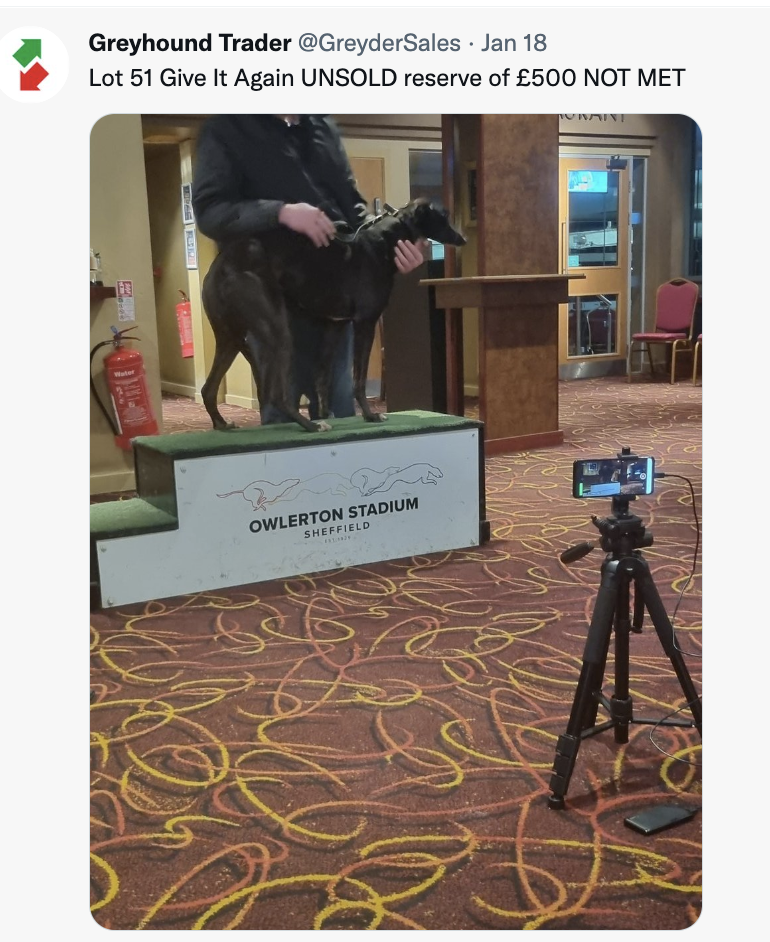
PLEASE PROTEST AND DEMAND TO KNOW WHERE THE UNSOLD GREYHOUNDS ARE GOING
It is well known that 83% of our greyhounds are Irish, they import them and sell them at sales for our race tracks. The ones that don't sell return to Ireland each month. They can either be destroyed, shot, sold at Irish auctions for pennies, or the British or Irish rescues will take them.
Not all of the 83% are traded at Sales. Many are purchased direct from the Irish breeders and transported to Britain.
Below are the people are organising these events please contact and protest.
OXFORD WEDNESDAY 1ST FEBRUARY 2023 BONUS SALE Gates Open: 9:00am ◆ Trials: 9:30am
February 22, 2023 Henlow Silver Sale
March 8, 2023 Towcester Pre-Derby Sale
April 27, 2023 Yarmouth East Anglian Sale
May 18, 2023 Oxford Pall Mall Sale
June 22, 2023 Doncaster Summer Sale
UPCOMING AUCTIONS
The auctions are using technology for auctions and this is happening frequently.
Ban Greyhound Racing in the UK
Greyhound racing in the United Kingdom takes place on both licensed and independent tracks. The Greyhound Board of Great Britain (GBGB) is the governing body for twenty-two licensed tracks in England and Scotland. Which in the last couple months has decreased seeing the closure of tracks in Manchester and Poole.
Approximately 83% of Greyhounds racing in the United Kingdom are Irish-bred.In 2008, there were 8,000 Greyhounds exported to Britain from Ireland.
In regards to Greyhounds bred in the United Kingdom, a total of 312 litters of Greyhounds were born in Great Britain in 2012. Almost 1,000 racing greyhounds died or were killed last year, according to industry figures, prompting Animal Welfare charities to renew calls for an end to the sport in the UK.
The Greyhound Board of Great Britain implements the Rules of Racing which are applicable to all GBGB license holders in the UK. These rules include regulations for race meetings, licensing requirements and doping policies. The independent tracks in England are also subject to the Welfare of Racing Greyhounds Regulations, which were passed by Parliament in 2010.4 These regulations primarily deal with licensing requirements for the tracks. There are no racing greyhound specific laws in Northern Ireland.
Between 2017 and 2019, 14,770 greyhound injuries were documented, including 706 track fatalities. An additional 2,036 greyhounds were reported euthanized for other reasons such as treatment costs or being designated as unsuitable for rehoming
source GREY2KUSA https://www.grey2kusa.org/about/worldwide/uk.php
The Disgusting and Horrific Treatment of Greyhounds in the UK
Racing dogs spend 95% of their time in small, barren kennels without social contact. Those that are housed in pairs are kept constantly muzzled which is highly distressing for them.
Many are neglected and suffer fleas, worms, untreated injuries, malnutrition and dental problems. .Poorly maintained tracks and racing frequency cause painful, and often lethal, injuries such as broken backs and shattered limbs.
Shockingly, the industry is allowed to keep injury records secret.At least 10,000 Dogs are deemed surplus to requirements every year. 8,000 are retired racers, the rest are young dogs that didn't make the grade.British charities re-home many surplus Dogs, but thousands are unaccounted for each year. Some are abandoned, some killed crudely, others sold for dissection.
source GREY2K USA Worldwide,
Many other Greyhounds are passed from trainer to trainer and only the lucky dogs end up in rescue centres for abandon dogs but the majority of Greyhounds are found mutilated or with their ears cut off to prevent the identity of the abuser/owner/trainer being found through the tattoo numbers insider their ears.
Ban the Exportation Of Greyhounds Globally
Greyhounds in Ireland, UK, Australia, New Zealand, Spain, and USA are being exported for racing Globally and breeding to countries with NO ANIMALS PROTECTION and countries that are involved in the barraric Dog and Cat Meat Trade.
Make it stand out
Whatever it is, the way you tell your story online can make all the difference.
This is What a Petition Can Achieve!
Petition: Ban greyhound racing to end unnecessary deaths & suffering of racing dogs
Over the last 6 months UK Government petition was circulated reached over 10,000 signatures which meant the Government were required to respond;
Government responded
This response was given on 26 November 2020
Defra supports high welfare for racing greyhounds, considers that welfare concerns are being addressed in many ways, and believes a ban is unnecessary.
The Petitions went on gaining 104,876 which will now be debated in parliament. this is
a first in the history of UK govt petitions to ban racing a date is being confirmed to when this will be happening.
https://petition.parliament.uk/petitions/554073
source AAGR are: ARK (Anti Racing Kent) Greyt Exploitations Greyhounds, Many Nation Facebook page

Please sign the petition Ban the Exportation of Greyhounds with the Exception of Rescue purposes only
Why Is The Greyhound Racing Industry is Not Being Held Accountable For The Death of Countless Greyhounds
The greyhound racing Industry is self-governed and regulated by the Greyhound Board of Great Britain also known as the GBGB
The GBGB are not answerable to any external government body. Therefore all disciplinaries are dealt with by the greyhound racing industry itself.
Disciplinaries are usually very weak, with trainers and owners being given meagre fines or even no punishment for cruelty to dogs, especially when dogs have been doped.
source Caged https://www.cagednw.co.uk/greyhoundcruelty.html
Structure of the Greyhound Racing industry :How it makes it’s BLOOD MONEY out death of Countless Innocent Greyhounds
The money makers in the industry are the bookmakers and £2.5 billion is staked annually on live greyhound racing in the UK.
At least 99% of all bets staked on British greyhound racing are through the Bookmakers Afternoon Betting Service (BAGS) meetings which are televised to the betting shops – streamed online and the internet by SIS – Sports Information Services Ltd – simply to supply a betting product for punters both nationally and internationally.
Only a handful of people attend the BAGS meetings that start as early as 10.30am – they are not held as social events as their sole purpose is to supply a betting product for gamblers and of course – to make huge profits for the bookmakers 11 hours a day – 7 days a week.
The British Greyhound Racing Fund
Approximately 3,588 greyhounds are forced to perform for the 46 race meetings held every week.
The British Greyhound Racing Fund are the industry’s body that collects the annual voluntary levy paid by the bookmakers and allocates these monies to various sectors of the industry in the form of grants.
The voluntary levy is calculated as 0.6% of the profits generated through the betting on dogs in the UK and is obviously paid 12 months in arrears.
Grants are awarded to various sectors of the industry – including marketing and promotion – welfare (including trainer’s prize money) – regulation and integrity – stadium improvement grants and trainer’s welfare grants.
The BGRF directors consists of track owners and bookmakers representatives – many of whom are directors of the very bookmakers who pay the levies. It is not surprising then that the bookmakers and track owners award themselves a large slice of the funds to refurbish their tracks.
In 2015 the bookmakers awarded themselves over £1.1 million – of their own money – in track grants while the Retired Greyhound Trust received just £1.4 million – sufficient money to home just 1,237 greyhounds at the current RGT’s average homing costs of £1,131 per dog.
The Greyhound Board of Great Britain & The Greyhound Regulatory Board
The Greyhound Board of Great Britain are responsible for governance and management – ensuring growth and commercial development of the industry.
The Greyhound Regulatory Board is incorporated within the GBGB but has independent status and is responsible for the management and enforcement of the Rules of Racing – the registration of licenced staff – trainers/owners and greyhounds. It is also responsible for drug sampling and betting integrity and investigates breaches of the Rules of Racing and conducting disciplinary hearings.
The Retired Greyhound Trust exists to provide homes for redundant racing greyhounds and in 2104 they ‘found homes’ for a amount of greyhounds.
The 70 regional branches are run by volunteers – many of which are located at licenced trainers kennels
The RGT receives its funding from the bookmakers levy and in 2104 were awarded a grant x amount of pounds which funds the homing of 1 in every 4 greyhounds
These ‘discriminated’ greyhounds amount to more than 7,000 annually and if not killed are indeed fortunate to make it to an independent rescue. More than 50% of the RGT’s funding comes from public donations and therefore the racing industry can only claim to fund for less than half of alleged 4,500 greyhounds re-homed last year.
Sourced from Greyhound Exploits https://greytexploitations.com/the-structure-of-the-greyhound-racing-industry/
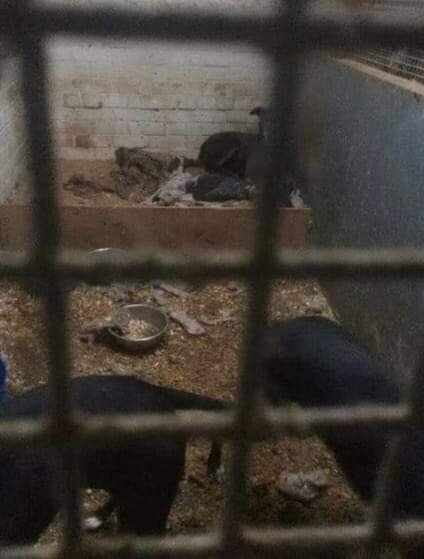

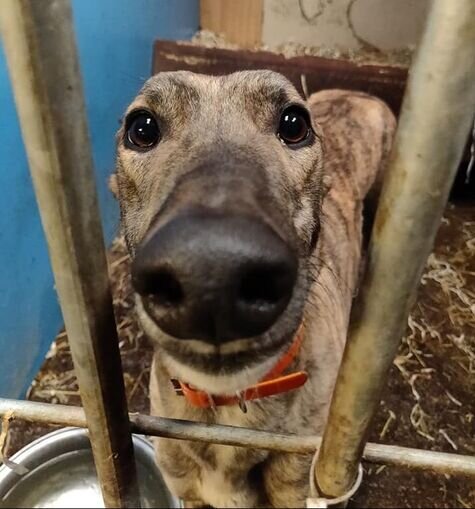
What The Greyhound Racing Industry Is Not Telling Anyone
Doping Dogs
Dogs are sometimes given illegal drugs such as Cocaine, Morphine and Amphetimines such as Speed. 'This can also be found on the GBGB website, under 'Disiplinaries' Dogs can either be sped up or slowed down.
Drugs are mostly used to speed a dog up.
Some dogs may be fed a heavy meal a few hours before a race to slow them down. This can cause bloat which is often fatal.
(The dogs stomach dilates and twists)Some dogs tend to run on the inside of the track and others on the outside
Therefore placing an outside dog in an inside trap – and an inside dog on an outside trap will cause them to cross the track to gain their usual running position.
Doing this means dogs will crash into one another and can cause devastation costing the lives of dogs.
Both doping of dogs and feeding before a race carries high risks for the dogs, including seizures, stroke, and death.
Source https://www.cagednw.co.uk/greyhoundcruelty.html
Injuries On The Track
Under the GBGB Rules, there must be a qualified vet at every GBGB licensed track while dogs are racing.
The vet checks each dog before a race but this does not protect the dog sufficiently because:
The vet is not given enough amount of time to examine the dogs properly which means dogs are often run with injuries. Unless injury or illness is obvious they will be raced, exacerbating the injury.
Some dogs may be given drugs such as anti inflammatories by their trainers to mask the pain so that they can still run.
These dogs will eventually fall, or go completely lame.Source https://www.cagednw.co.uk/greyhoundcruelty.html
Why are dogs raced with injuries?
Some trainers dogs are used for live streaming (TV broadcasting across the world)
These are called BAGS trainers.
Bags means Bookmakers Afternoon Greyhound ServiceGreyhound Trainers may;
A) Own their dogs
B) Kennel them for other owners
C) Part own dogsFor every dog entered in a BAGS race, a trainer is usually paid in the region of £20 to £40, depending on the track. The dog does not have to be placed. Payment is given even for the losers. Dogs have even been raced while blind or partially blind.
Source https://www.cagednw.co.uk/greyhoundcruelty.html
When a dog gets injured on the track
If it's a serious injury and the dog remains alive after the fall, the dog will be carried to the vet room usually by the owner, trainer, or any other assisting person but not normally by a qualified veterinary person.
If a dog has a break, especially in the spinal region, it may be made worse by moving the dog inappropriately (by an unqualified veterinary professional)
There are barely any resources at the track for an injured dog. There is only a vet room and a vet who can administer drugs such as painkillers or euthanasia.
We have been advised by insiders that dogs on many occasion are unnecessarily euthanised if a track vet does not carry enough painkillers to the track.
A dog may be sent home with an injury such as a broken hock after being given painkillers. Dogs are raced often of an evening, when vet practices are not open, and call out fees are expensive, therefore dogs may be left overnight without any emergency care, x-rays etc, other than the pain killers given by the vet.
(If a dog is sent home and later destroyed it will not show on the tracks data for deaths recorded due to injury. This benefits the track management, giving their reputation a boost for less injured dogs destroyed at their track)
There is no guarantee a dog will be taken to a vet surgery after he/she has left the track. There are no follow up checks. Dogs may be left lame, for example with broken toes, hocks etc, for months with no treatment given.
Some will have calcified joints or horrific bone malformations due to being left without treatment.
Many of these cases have been witnessed by rescue centres and campaigners
RSPCA
The RSPCA are part of the greyhound forum, the Greyhound forum works with the industry supposedly to bring better welfare.
source Caged https://www.cagednw.co.uk/greyhoundcruelty.html
Disposal /Destructruction Of The Greyhounds
The Captive Bolt Gun
It is legal for any person to destroy greyhounds using a captive bolt gun. No training or license is required by law.
In 2006 David Smith, based in County Durham killed around 10,000 greyhounds by use of a bolt gun.
He buried them on his own land. Mr Smith was not punished other than a small fine for wrongful disposal as he did not incinerate the bodies. Today there will no doubt be other Mr Smiths providing a similar service behind closed doors.
David Smith charged just £10 to kill a dog using the bolt gun.
Use of the Captive bolt gun.
The bolt gun is placed on a specific area of the skull – If misplaced, it will cause horrific injury and will not render the dog fully unconscious.
This may cause the killer to make repeated attempts, destroying the dog in a most inhumane manner, while causing horrific pain, terror and suffering.
Injury figures
The GBGB have refused to release data for injury and death of dogs until recently. They have released data for the year 2017, following a parliamentary inquiry which forced them to.
Injuries 2017 (4,837 )2018 (4,963) 2019( 4,970)
Deaths -2017 (257) 2018 (242) 2019 ( 207)
source https://www.aagr.org.uk/2020/09/07/injuries-death/#more-24
Please note these figures do not include dogs that are no longer registered to race.
For example, dogs are often passed on to non licensed track also known as a flapping track after they finish racing on a licensed track, this means they are no longer registered with the GBGB (A retirement form is completed by the owner and supposedly submitted to the GBGB)
Dogs are very often destroyed at flapping tracks. A vet may attend a flapping track specifically to destroy dogs that are not fast enough, injured, or just no longer wanted for racing. These death figures are not recorded.
Homed dogs are also often retained dogs, this means they are kept by their trainer/owners when they are no longer racing on a licensed track.
These dogs are no longer registered to race so are classed as 'no longer' responsible for by the GBGB therefore they may be later;
1) Exported to race or for breeding, to countries where there are no welfare laws to protect them, such as Pakistan, Spain, China, Romania, etc
2) Used for breeding in trainers kennels, until they are no longer producing, and then destroyed
3) Sent onto race at flapping tracks
4) Kept on allotments in horrific conditions, with little to no proper shelter, bedding, stimulation, or vet treatment – also left outdoors in freezing weather throughout the winter.
The Decline Of Greyhound Racing In the UK
Over the year there has been a decline in Greyhound Racing in the UK active 19 racecourses ..Many people have become aware of the sheer barbaric cruelty and how the Greyhounds are treated. Countless amount of people have continues to campaign to closed tracks down and continue to do so every weekend.
Manchester Belle Vue closed last year after opening in 1926 is was MASSIVE achievement to have this race course closed down




















